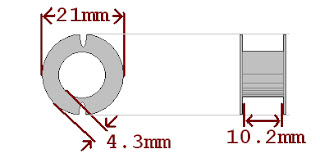 |
| Two Series Coils with a Full Wave Rectifier |
This is an OK setup in most situations. It lets us harvest energy from both the positive and negative spikes of voltage in the coils. Additionally, the series coil setup is the only one that makes sense if the coils are not going to be excited by the magnetic field at the same time. So everything should work fine.
The issue is that the full wave rectifier means that the coil voltage is reduced by two diode forward voltage drops before its gets a chance to charge the batteries. These forward voltage drops are anywhere from 0.7-0.3V. I specifically chose my diodes to have a small voltage drop, but when you are only dealing with a 1.3V battery voltage, a voltage drop of about 0.5V is a big deal. So using a half wave rectifier may be a better choice. In this case, you only get to harvest the positive voltage spikes, but you get more out of them, as there is only a single diode drop. This setup would be something like this:
 |
| Two Series Coils With a Half Wave Rectifier |
So i ran some tests today to compare the two approaches. My prototype board was setup originally to make these specific tests easy, so not too much work was involved. These tests where taken at what would be a decent pace on my bike. Here are the results.
 |
| Series Coils With a Full Wave Rectifier |
 |
| Series Coils With a Half Wave Rectifier |
It looks like either choice is OK. Although we are getting less frequent current spikes into the batteries with a half wave rectifier, we are getting much more current per spike (almost 18.5mA peak vs. 12mA peak), for a comparable average charging current (1.5mA vs. 1.45mA). Since the full wave rectifier needs larger voltages, it works better for charging at higher wheel speeds, while the half wave rectifier will charge at lower speeds. Apparently in the middle it doesn't matter. As i'm more likely to go slower on average around town rather than faster, ill change my coil setup to have a half wave rectifier.
An additional issue is the coil resistance. This was touched on in my last post, but its practical implications where mostly ignored. I'm using very thin wire so i can get the size of my coils down while still using lots of turns. Thinner wire has a larger resistance per meter, and since i'm using so much thin wire, i end up with about 35Ohms of resistance per coil. In a series connection, the coil being excited by the magnets has to drive the resistance of the other coil, as well as the rectifier diodes. This means that as a magnet passes a coil, you end up with the situation seen below.
 |
| Equivalent Circuit During Coil Excitation |
Needless to say, this is not ideal. In addition to a voltage drop you have a relatively large resistor in the way. A better solution may be the one below.
 |
| Improved Half Wave Coil Setup |
Originally i wasn't sure that a half wave vs a full wave was going to make much of a difference and i didn't want to put two full wave rectifiers on the board, so i ignored this setup. But since I'm going to use half wave rectifiers anyway... i thought i might as well give it a shot.
 |
| Two Coils With Dual Half Wave Rectifiers |
With the same test as before, this setup behaves better. we are up to almost 2.5mA charging current, which is really quite good. Note that to set this up on my board, i inverted one of the coils, which is why it looks like I'm harvesting positive spikes from one coil and negative spikes from the other. This will probably be my final design for the coil rectifiers. I'm glad i took a look at this as the changes made almost doubled my available charging current.
